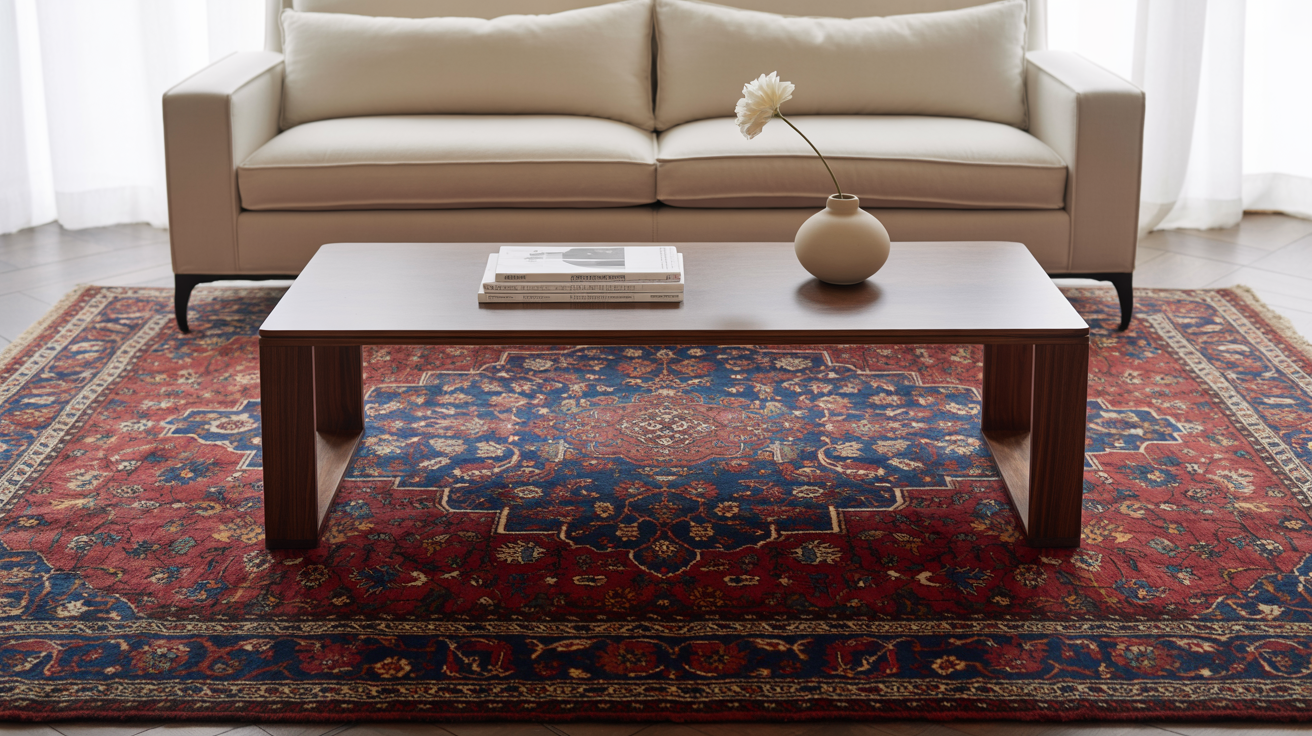Placing a rug in a living room properly can greatly enhance the space’s comfort and style. Start by selecting a rug that fits the scale of your room and furniture. Ideally, in a spacious living room, all the main furniture pieces—such as the sofa, chairs, and coffee table—should sit entirely on the rug to create a cohesive look. In smaller spaces, it’s acceptable for just the front legs of the furniture to rest on the rug, helping to anchor the seating area without overwhelming it.
Make sure the rug is centered in relation to the main furniture and leaves equal space on all sides if possible. Avoid rugs that are too small, as they can make the room feel disjointed. A well-placed rug not only defines the area but also adds warmth, texture, and color to the room.
I spent years arranging and decorate my own living room, trying to understand why it never quite came together. The furniture was beautiful, the art was thoughtfully chosen, but something wasn’t clicking. Then a designer friend walked in and immediately said, “Your living room rugs are floating.” That simple observation changed everything. The right rug, properly placed, transformed my living room from a collection of furniture into a cohesive, welcoming space where conversation flows and relaxation comes easily.
Let’s explore how to harness this design superpower and give your living room the foundation it deserves.
1. Minimalist Elegance: How a Textured Rug Anchors Modern Living Room
This living room beautifully demonstrates the power of a well-placed area rug in a contemporary setting. The large, cream-colored textured rug creates a defined conversation area, extending generously beyond the furniture to unify the sitting space. Its subtle geometric pattern and soft, plush texture add warmth to the sleek wooden flooring while complementing the living room’s neutral palette. Note how the living room rug’s placement allows it to sit under the front legs of the sofa and completely encompass the unique rattan coffee table, creating a cohesive zone that feels intentionally designed rather than haphazardly arranged.
The rug works in perfect harmony with the room’s standout features—the striking line art wall mural of abstract faces and the minimalist furniture selections. By choosing a light-colored rug with interesting texture rather than bold patterns, the homeowner has wisely avoided competing with the statement wall while still adding visual interest to the floor. This approach creates a sophisticated balance, allowing the eye to travel from the dramatic wall art down to the textural details of the rug, with the neutral gray sofa and sculptural coffee table bridging these elements.
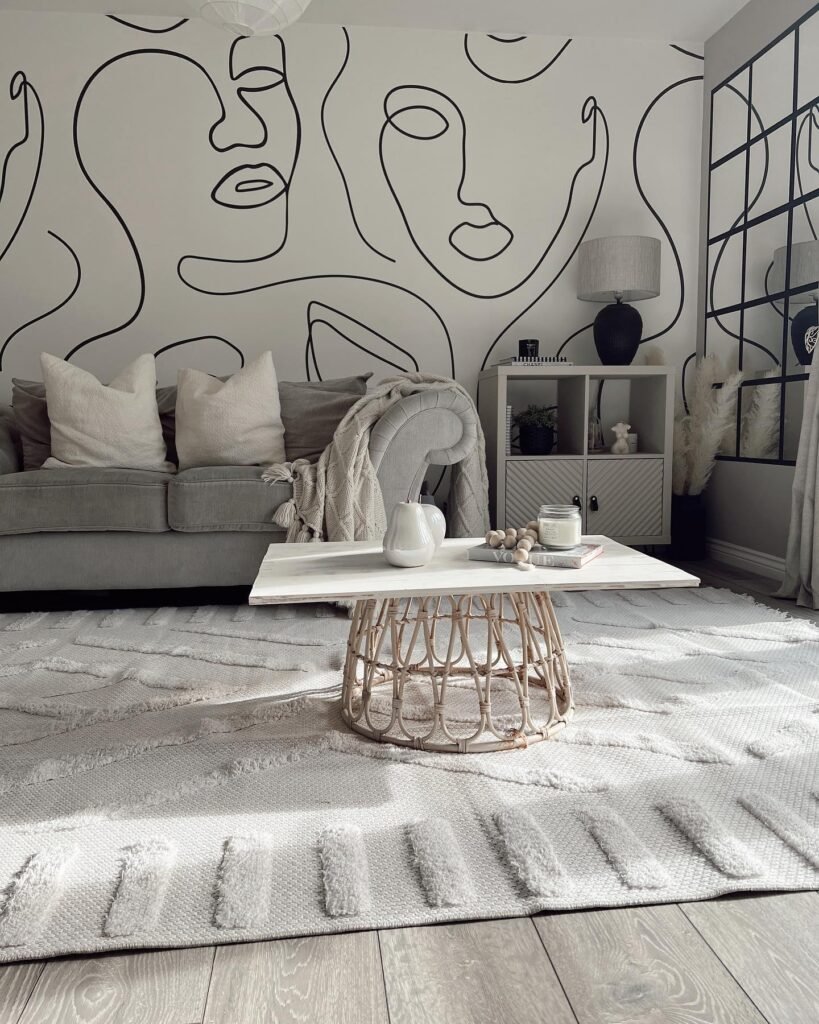
2. Oceanic Waves- Creating Visual Interest in Transitional Spaces
This striking kitchen-adjacent space showcases the transformative power of a statement rug in an open-concept design. The undulating blue and white pattern—reminiscent of rippling ocean waves—introduces a captivating focal point to an otherwise minimalist area. Strategically placed between the sleek black kitchen island and the outdoor living room, the rug carves out a distinct zone within the open floor plan. The positioning is particularly clever, as it creates a visual boundary without interrupting the flow between indoor and outdoor environments, allowing the warm wooden bar stools to appear as if they’re floating above an azure sea.
What makes this arrangement especially effective is how the rug’s organic, fluid pattern contrasts beautifully with the geometric architectural elements surrounding it—the linear kitchen cabinets, rectangular sliding doors, and cylindrical wooden stools. The blue tones thoughtfully echo the glimpse of sky visible through the expansive windows while simultaneously bringing the outdoor greenery visually into the space.
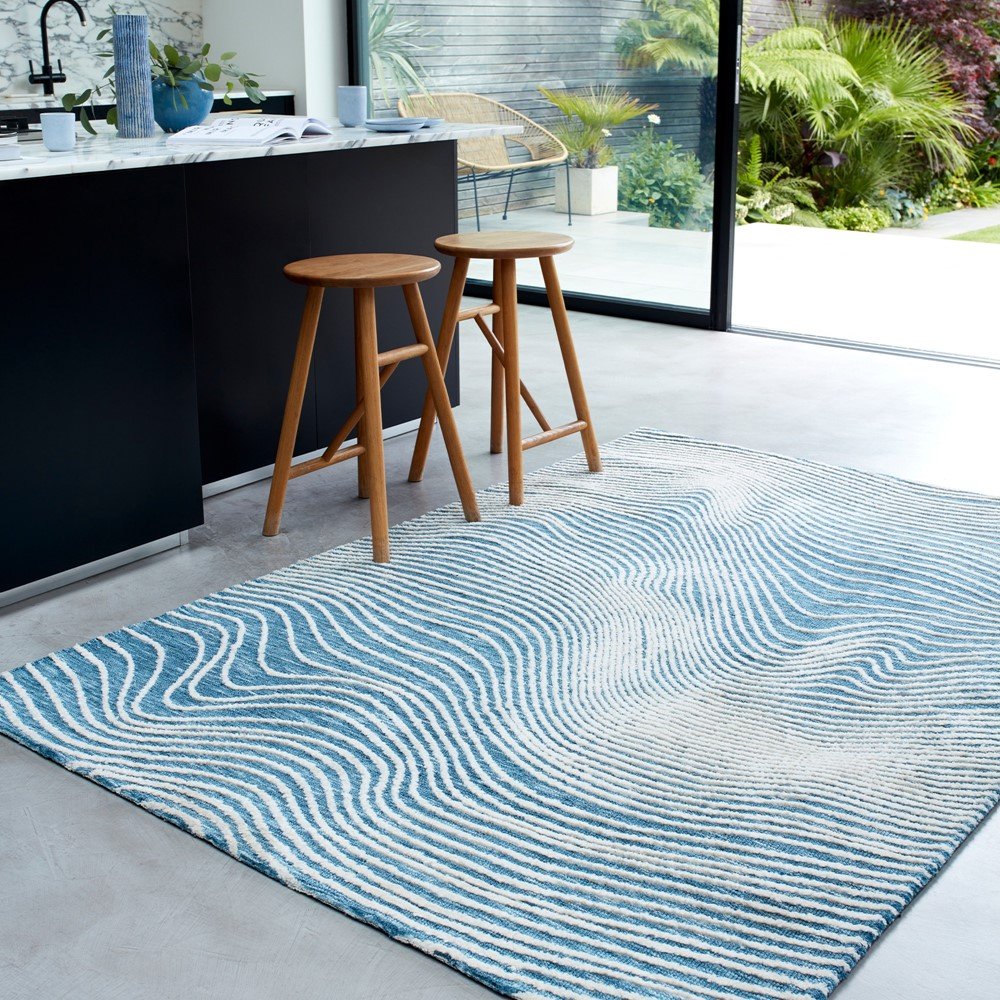
3. Monochromatic Elegance – Defining Conversation Areas with Light Neutrals
Place a rug in a living room perfectly illustrates how a well-placed area rug can define and enhance a conversational seating arrangement. The large, pale, neutral rug creates a cohesive foundation that unifies the curved white sofa and armchairs, establishing an intimate gathering space centered around the striking black coffee table.
Notice how the rug extends generously beyond the furniture perimeter—a design choice that makes the modest-sized room feel more spacious and deliberate. The light color of the rug also cleverly brightens the space, reflecting the natural light from the shuttered windows.
What’s particularly masterful about this arrangement is the way the designer has used the rug to soften the room’s architectural lines and add subtle texture without competing with the elegant simplicity of the furnishings. The living room rug’s placement—centered in relation to both the fireplace and the furniture grouping—creates a balanced, harmonious feel that draws the eye naturally around the space.
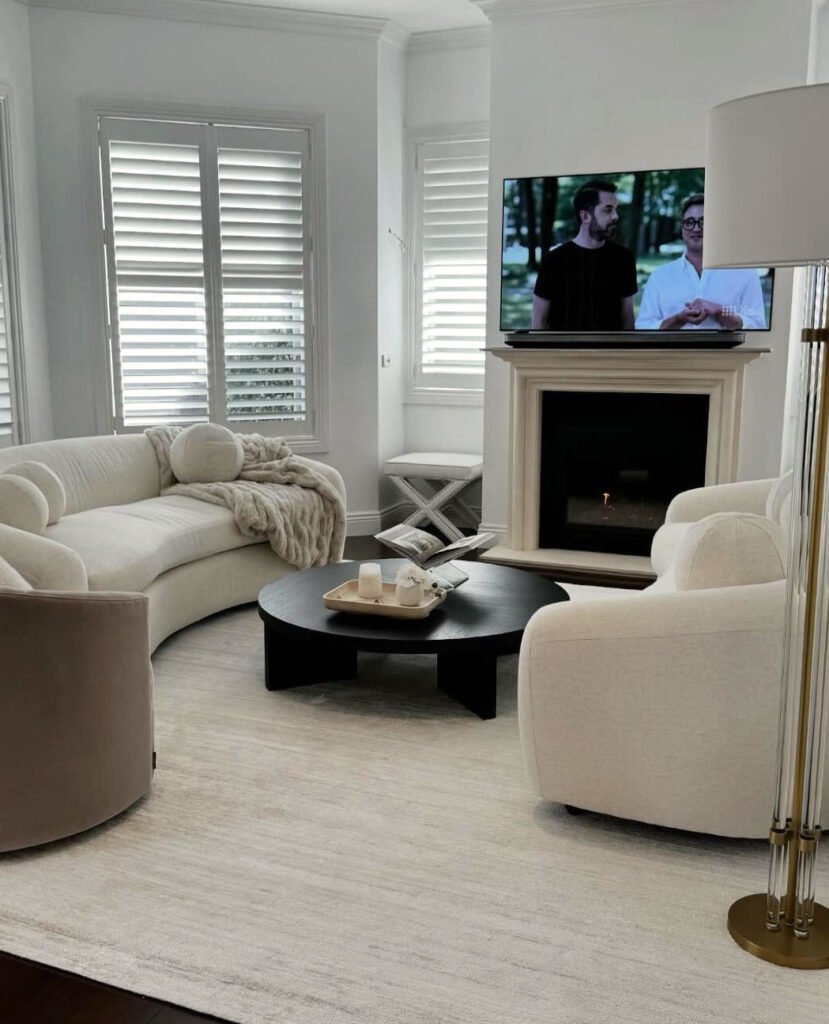
4. Bold Contrast – Making a Statement with a Dramatic Blue Rug
This contemporary open-concept living room showcases the powerful impact a boldly colored rug can have on an otherwise neutral palette. The rich navy blue area rug serves as the room’s commanding centerpiece, creating a defined living room within the larger open floor plan that seamlessly connects to the kitchen and dining areas. What makes this design choice so effective is how the deep blue creates striking visual contrast against the light wooden floors, crisp white walls, and soft gray furnishings.
Notice how the designer has thoughtfully ensured all major furniture pieces rest comfortably on the rug, creating a cohesive seating arrangement that feels intentional and grounded. The blue tone cleverly picks up subtle colors from the outdoor greenery visible through the dramatic floor-to-ceiling windows, drawing the eye across the space and connecting interior with exterior.
This exemplifies a key principle of statement rug placement: when using a bold color in an otherwise neutral room, ensure the rug is properly sized to unite all furniture elements and positioned to define functional zones within open spaces—transforming what could be a cavernous area into an intimate, welcoming gathering spot.

5. Vintage Warmth – Using Pattern and Texture to Create Organic Harmony
This serene living room brilliantly demonstrates how a vintage-inspired patterned rug can add warmth, character, and cohesion to a minimalist space. The faded terra cotta and neutral-toned area rug introduces subtle complexity through its traditional pattern while maintaining the room’s calm, organic aesthetic.
Perfectly proportioned to the seating arrangement, the rug extends just beyond the furniture’s perimeter—a classic placement technique that creates visual balance while ensuring the entire conversation area sits comfortably within its borders. The strategic positioning allows the rug to frame the substantial wooden coffee table while still revealing enough of the light flooring to maintain the room’s airy quality.
What’s particularly masterful about this arrangement is how the rug’s muted palette harmonizes with both the modern architectural elements—like the dramatic vaulted ceiling and black-framed windows—and the room’s natural, earthy accents. The vintage pattern complements rather than competes with the rustic wooden coffee table and textural ceramic vessels, creating a layered, collected-over-time feeling that softens the home’s contemporary lines.
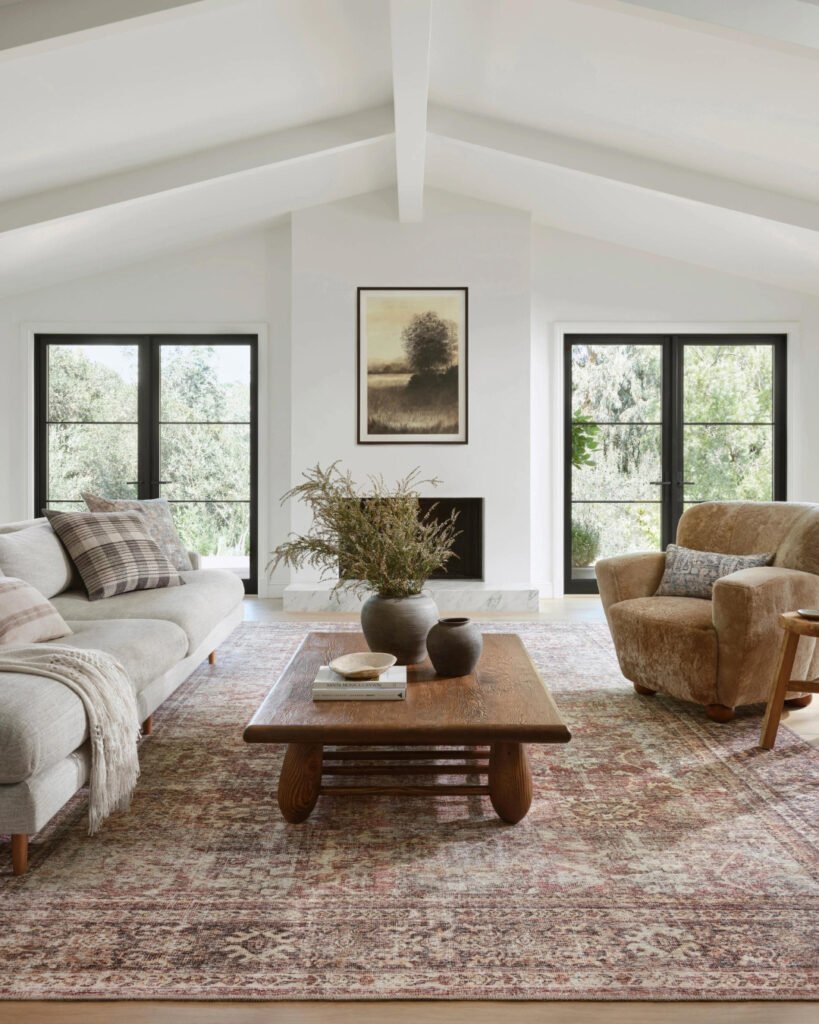
6. Geometric Elegance – Using Pattern to Add Visual Interest to Minimal Spaces
This sophisticated entryway demonstrates how a carefully selected patterned rug can transform a minimalist space into one with character and warmth. The geometric amber-toned area rug introduces a structured grid pattern that creates visual interest against the room’s neutral cream marble flooring and white walls.
Positioned centrally in this transitional space, the rug defines a distinct area while maintaining enough bare floor around the perimeter to showcase the beautiful stone beneath. This placement technique—allowing a consistent border of flooring to frame the rug—prevents the space from feeling crowded while still providing adequate coverage for the high-traffic entryway.
What makes this arrangement particularly effective is how the rug’s earthy palette harmonizes with the rich wooden tones of the record cabinet, creating a cohesive color story throughout the living room. The geometric pattern, with its subtle rust and cream accents, adds complexity and depth without overwhelming the room’s clean architectural lines. This exemplifies a key principle in rug placement for transitional spaces: selecting a design that bridges different rooms and design elements while standing confidently on its own.
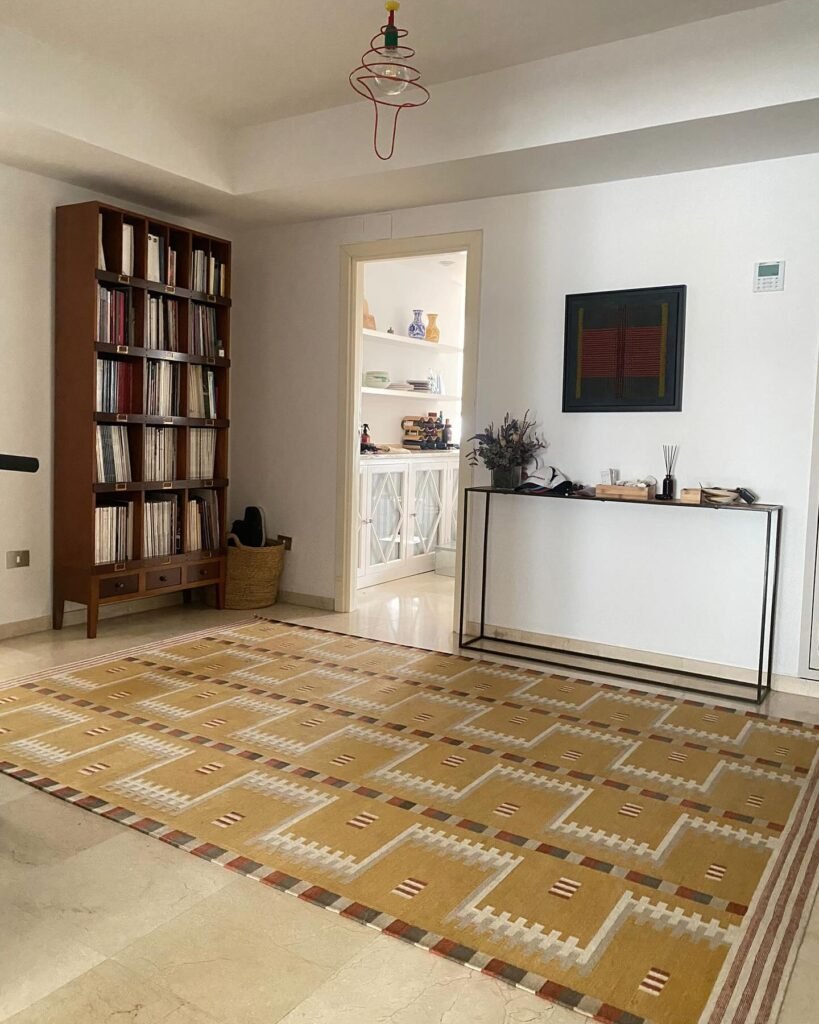
7. Bold Statements – Creating Drama with Graphic Patterns in Traditional Settings
This charming living room showcases the transformative power of a boldly patterned rug in a heritage-inspired space. The striking diamond motif rug in contrasting charcoal and cream creates immediate visual drama beneath the tufted leather Chesterfield sofa.
Rather than playing it safe with a traditional pattern that might be expected in this Americana-themed room, the designer has opted for a graphic, almost modern design that energizes the entire space. The rug is precisely sized to extend just beyond the sofa and coffee table—creating a well-defined conversation area—while still allowing the warm wood flooring to shine around its borders.
What’s particularly masterful about this placement is how the rug’s geometric pattern provides a surprising contemporary counterpoint to the room’s more traditional elements—the tufted leather sofa, antique wooden furniture, and vintage collectibles. The diagonal lines create movement and energy, drawing the eye toward the light-filled French doors while anchoring the substantial furniture pieces.
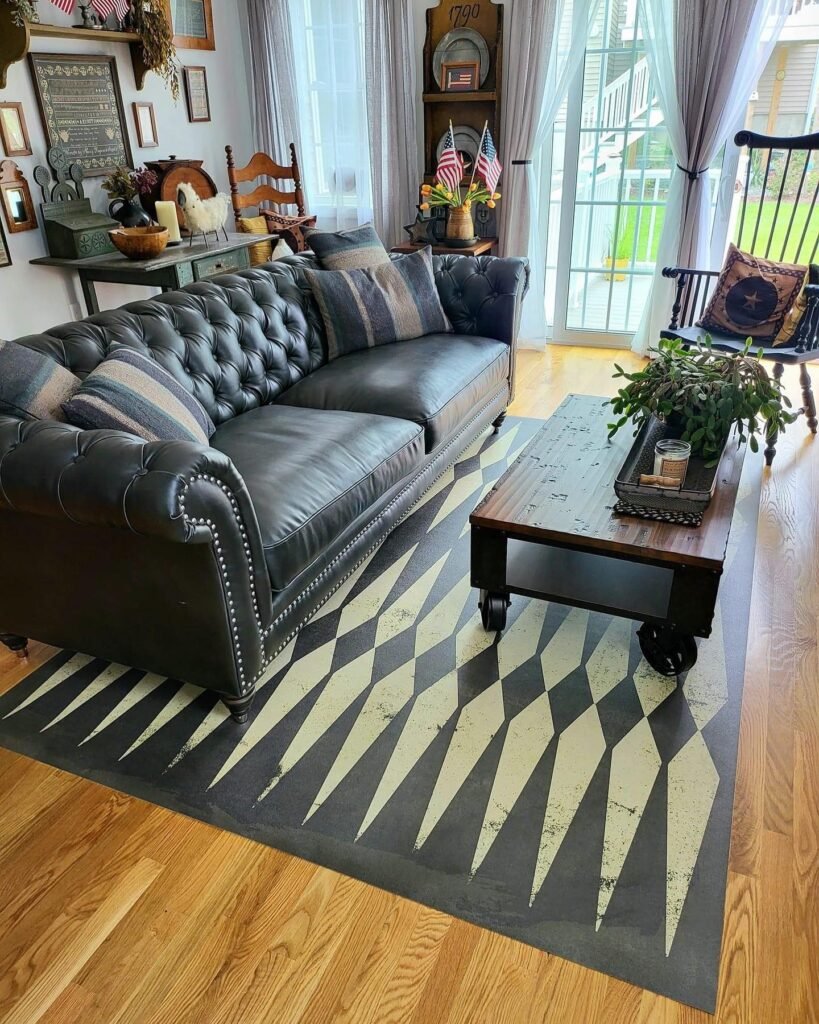
Wintry Whispers – Creating Atmosphere with Abstract Textural Rugs
This serene living room exemplifies the impactful role a large abstract rug can play in completing a minimalist design scheme. The expansive distressed rug, with its moody palette of silver, charcoal, and subtle taupe, creates a perfect foundation for the understated gray sofa.
What makes this arrangement particularly striking is how the living room rug’s weathered, almost ethereal pattern beautifully echoes the snowy landscape visible through the generous windows. This visual connection between interior and exterior elements creates a harmonious flow that makes the space feel intentionally designed rather than coincidentally assembled.
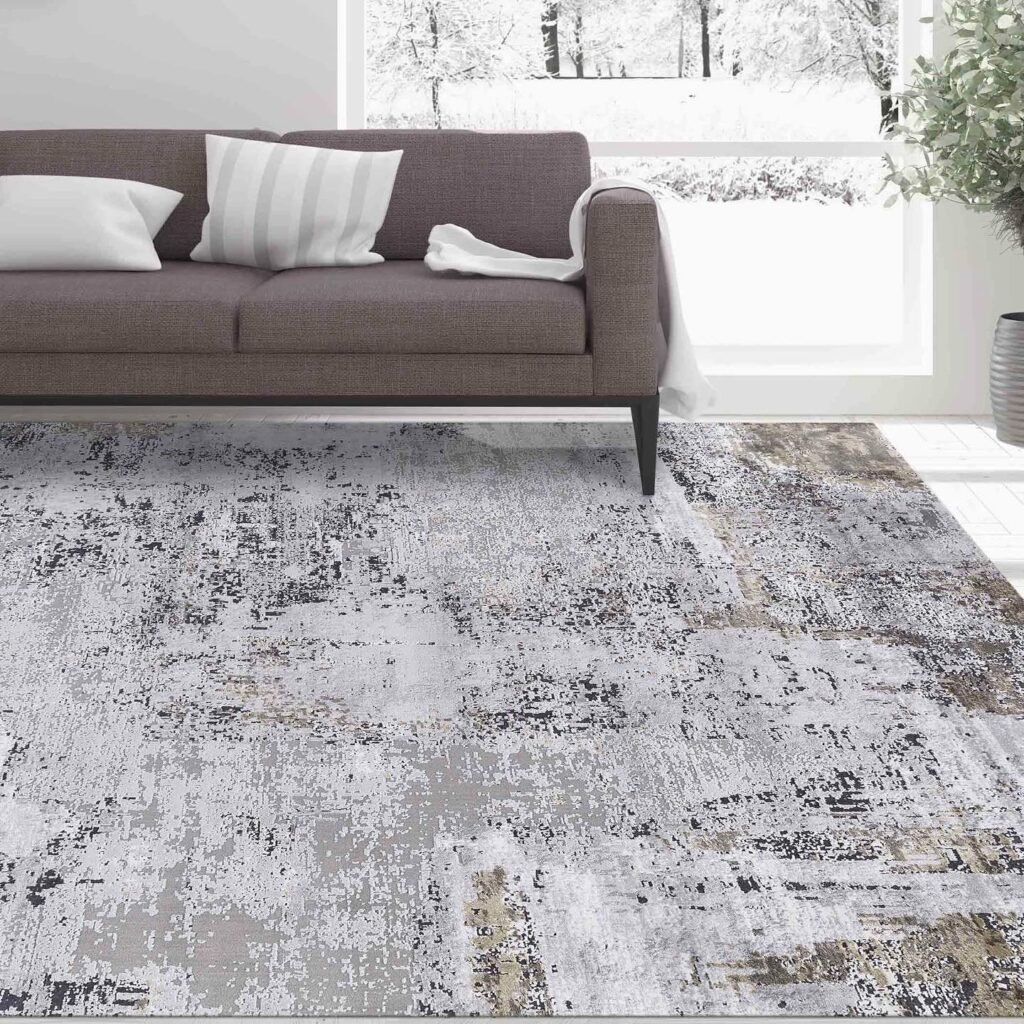
Conclusion
Placing a rug in your living room the right way can completely transform the feel and function of the space. From choosing the correct size to aligning it with your furniture layout, every detail matters. As trends evolve in 2025, the focus remains on comfort, balance, and visual flow—ensuring your rug doesn’t just sit there but truly enhances your room. Whether you’re creating a cozy conversation zone or defining an open-plan layout, a well-placed rug is a timeless design move that pulls everything together with purpose and style.

